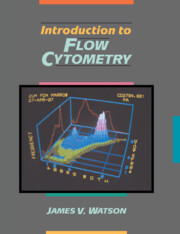Book contents
- Frontmatter
- Contents
- Acknowledgements
- 1 Introduction
- 2 Fluid flow dynamics
- 3 Light and optics
- 4 Electronics
- 5 Computing
- 6 Cell sorting
- 7 Preparation and staining
- 8 Miscellaneous techniques
- 9 Instrument performance
- 10 Light scatter applications
- 11 Nucleic acid analysis
- 12 Nucleic acids and protein
- 13 Chromosomes
- 14 Dynamic cellular events
- 15 Applications in oncology
- 16 Epilogue
- References
- Index
5 - Computing
Published online by Cambridge University Press: 27 October 2009
- Frontmatter
- Contents
- Acknowledgements
- 1 Introduction
- 2 Fluid flow dynamics
- 3 Light and optics
- 4 Electronics
- 5 Computing
- 6 Cell sorting
- 7 Preparation and staining
- 8 Miscellaneous techniques
- 9 Instrument performance
- 10 Light scatter applications
- 11 Nucleic acid analysis
- 12 Nucleic acids and protein
- 13 Chromosomes
- 14 Dynamic cellular events
- 15 Applications in oncology
- 16 Epilogue
- References
- Index
Summary
Computing procedures in flow cytometry, particularly for multi-parameter analysis, are becoming increasingly sophisticated. Developments are taking place rapidly and a number of packages, independent of the large organizations (Beckton–Dickenson and Coulter), are becoming available commercially. The every-day user of the technology is increasingly at the mercy of the packaged product menu and many of these, be they from large or small organizations, have limitations. This section is included to familiarize the totally uninformed reader with the most basic vocabulary and computing processes so that if you have to request, complain or argue about something with a supplier you will at least have some idea of what the words mean. Anyone who knows all about bits, bytes and binary should skip the next subsection. If you also know how to process eight-dimensional data, manipulate six-parameter data, display three-dimensional data in stereo, perspective and in colour and assess distribution shapes with 28K addressable memory using a micro-processor then skip all these subsections and GOTO cell sorting.
Bits, bytes and binary
In order for the non-informed to understand some of the processes involved we must start with some definitions, a respresentation of how numbers are stored by a computer and a description of how some of the operations are carried out. A storage location is called a word. That wasn't too difficult was it? Remember I'm writing for biologists. Generally, a word contains 16 bits, which is equivalent to 2 bytes and it doesn't take the greatest intellect in the world to appreciate that there must be 8 bits in a byte.
Information
- Type
- Chapter
- Information
- Introduction to Flow Cytometry , pp. 74 - 105Publisher: Cambridge University PressPrint publication year: 1991
